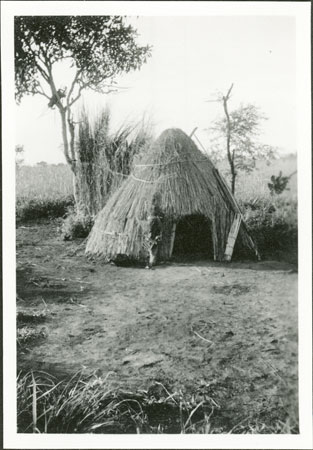Anuak dry season shelter

82 x 55 mm | Print gelatin silver
There are records relating to alternative images that we do not have scans for in the database:
1998.342.71.1 - Negative film nitrate , (82 x 55 mm)
1998.342.71.1 - Negative film nitrate , (82 x 55 mm)
Date of Print:
Unknown
Previous PRM Number:
EP.AK.71
Previous Other Number:
19 2 (183)
Accession Number:
1998.342.71.2
Description:
A small domed hut with a low entrance and a short section of fence behind, identified as a dry-season camp (location unknown).
For villages situated at the edge of the wet season flood extent such as the districts of Ciro, Oyuaa, and Adongo along the Oboth, and Nyikaani district of the Akobo, it was often necessarily to move in the drought to locations closer to the river for fishing and everyday water needs.
Since Evans-Pritchard was in Anuakland during the drought he was able to photograph shelters used during this time of the year.
Photographer:
Edward Evan Evans-Pritchard
Date of Photo:
1935 March - May
Region:
[Southern Sudan] Jonglei
Group:
Anuak
PRM Source:
Edward Evan Evans-Pritchard
Acquired:
Donated 1966
Other Owners:
E. E. Evans-Pritchard Collection
Class:
Settlement , Shelter , Water Supply
Keyword:
Building House
Primary Documentation:
PRM Accession Records - Accession Book Entry [p.
98] 1966.27 [1 - 24] G[ift] PROFESSOR E.
E.
EVANS-PRITCHARD; INST.
OF SOCIAL ANTHROPOLOGY, 51 BANBURY RD.
OXFORD - 1966.27.19 - S.
SUDAN, DARFUNG.
VARIOUS TRIBES.
Box of negatives in envelopes, [1 - 242] & 1966.27.20 - Box of prints of these negatives [refers to object 1966.27.19] [1 - 242], in envelopes.
Notes on print/mount - "19 2 183 dry season camp"
Notes on print/mount - "19 2 183 dry season camp"
Other Information:
In The Political System of the Anuak of the Anglo-Egyptian Sudan (monographs on Social Anthropology no.4, London School of Economics, 1940) page 16, E.
E.
Evans-Pritchard notes that 'In the area of true savannah the villages which drink water brought down by the Akobo and Oboth are built on slightly elevated ground at the edge of their flood plains where thin thornwood begins.
Consequently their occupants may have to move in the drought not only for fishing and grazing but also even for drinking-water unless they are prepared to fetch water from two or three miles away as the people of Owelo and Ugin were doing in 1935...
dry season camps are made on large mounds which are dotted here and there at the edge of the dry season extension of the marshes.
These mounds, perhaps the accumulation of centuries of camp debris, are generally fringed by a circle of magnificent trees, chiefly sycamores and tamarinds.'[Chris Morton 19/12/2003]
Recorder:
Christopher Morton 19/12/2003 [Southern Sudan Project]

